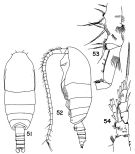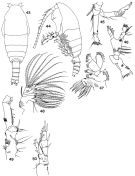|
|
 |
|
Calanoida ( Order ) |
|
|
|
Spinocalanoidea ( Superfamily ) |
|
|
|
Spinocalanidae ( Family ) |
|
|
|
Spinocalanus ( Genus ) |
|
|
| |
Spinocalanus usitatus Park, 1970 (F) | |
| | | | | | | Syn.: | Spinocalanus pteronus Park, 1970 (p.487, figs.F) | | | | Ref.: | | | Park, 1970 (p.475, 483, 487, Descr.F, figs.F); Damkaer, 1975 (p.58, figs.F); Bode & al., 2017 (p.600, Table I, fig. 2, 3, 4, morphology vs genetic). |  issued from : D.M. Damkaer in NOAA Technical Report NMFS CIRC-391, Seattle, 1975. [p.58, Fig.137-140]. Female: 137, habitus (dorsal); 138, idem (left lateral side); 139, Mx2 (inner and terminal setae omitted); 140, basipod segments 1 and 2 of Mxp.
|
 Issued from : T. S. Park in Bull. Mar. Sc., 1970, 20 (2). [p.488, Figs.51-54]. Female (from Caribbean Sea & G. of Mexico): 51, habitus (dorsal); 52, idem (lateral left side); 53, basipod of Mxp; 54, P1. Nota: prosome about 3 times as long as urosome. Ventrolateral edges of cephalosome inconspicuous. lateral side of metasome with spinules. Coxa of Mxp with a comb of large spines. Other appendages as in S. pteronus
|
 Issued from : T. S. Park in Bull. Mar. Sc., 1970, 20 (2). [p.488, Figs.43-54]. As Spinocalanus pteronus. Female: 43, habitus (dorsal); 44, idem (lateral left side); 45, A2; 46, Md; 47, Mx1; 48, Mx2; 49, basipod of Mxp; 50, P1 (anterior).
|
 Issued from : M. Bode, S. Laakmann, P. Kaiser, W. Hagen, H. Auel & A. Cornils in J. Plankton Res., 2017, 39 (4). [p.605, Table I]. Species identified via morphological and molecular analyses, including the number of specimens used for each identification method (MI: morphological identification, COI: cytochrome c oxydase subunit I gene fragment, MS: MALDI-TOF analysis, 18 S: ribosomal 18 S gene fragment). Cryptic lineages were revealed only after molecular analysis. Sampling depth, latitude, total length (TL) and Prosome/Urosome ratio (Pr:Ur) of taxon were recorded. morphological characters are only listed here, if the identification was ambiguous due to missing body parts or if cryptic or pseudocryptic lineages were revealed during molecular analyses. For diagnostic character of species refer to the references: Park, 1970; Grice, 1971; Damkaer, 1975; Schulz, 1989, 1996. C = coxa; B = basis; P = swimming legs.
| | | | | Compl. Ref.: | | | Medellin-Mora & Navas S., 2010 (p.265, Tab. 2) | | | | NZ: | 7 | | |
|
Distribution map of Spinocalanus usitatus by geographical zones
|
| | | | | | | Loc: | | | SE Atlant. (3°N-25°S), NW Atlant. NW (Caribbean Sea, Caribbean Colombia, G. of Mexico), Pacif. (off NE Marquesas Is., off California), China Seas (South China Sea) | | | | N: | 6 | | | | Lg.: | | | (13) F: 1,93-1,38; (88) F: 1,76-1,7; (88') F: 2,08-1,86; (1252) F: 1,76-1,98; {F: 1,38-2,08}
(1252) F: 2,3-3,1. | | | | Rem.: | Mesopelagic. 800-5000 m (in Bode & al., 2017 in SE Atant. 3°N-25°S).
Damkaer (1975) considers that one of the forms (1.8 mm) cited as S. spinosus by Vervoort (1946, p.153) NW of the Indian Ocean could belong to this species.
For Park (1970, p.489) distinguishes two species (pteronus and usitatus ) by the size of the body (1.86-2,08 in the former and 1,7-1,76 in the latter) and the ventrolateral edges of the cephalosome.
After Hsiao & al. (2004, p.329) thie species is new to the East region of Taiwan.
After Bode & al. (2017, p.612), high morphological similarities explain why species initially described as S. pteronus Park (1970) is synonymous with S. usitatus Park, 1970. | | | Last update : 27/03/2020 | |
|
|
 Any use of this site for a publication will be mentioned with the following reference : Any use of this site for a publication will be mentioned with the following reference :
Razouls C., Desreumaux N., Kouwenberg J. and de Bovée F., 2005-2025. - Biodiversity of Marine Planktonic Copepods (morphology, geographical distribution and biological data). Sorbonne University, CNRS. Available at http://copepodes.obs-banyuls.fr/en [Accessed January 02, 2026] © copyright 2005-2025 Sorbonne University, CNRS
|
|
 |
 |






